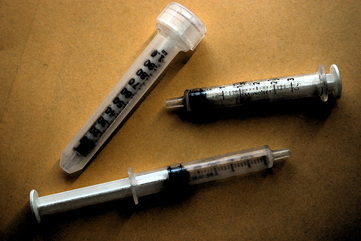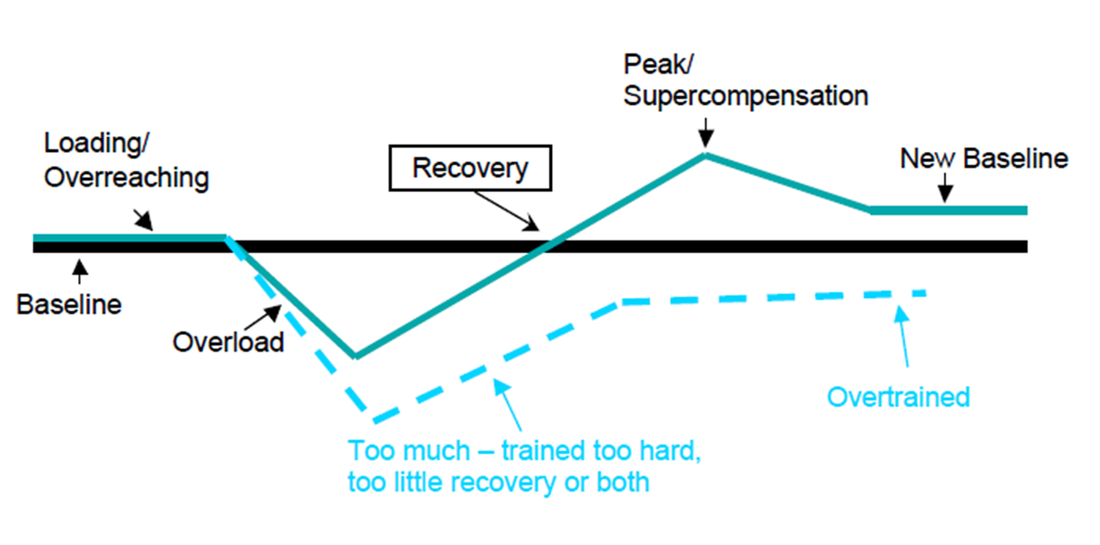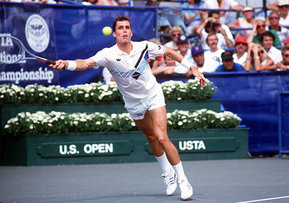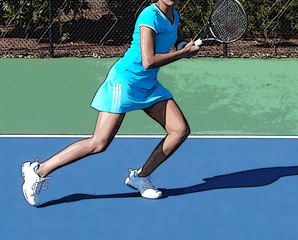- at what number of matches in a single tournament does the medical withdrawal rate substantially increase?
- does different ages of competition result in different injury rates?
- do males have more medical withdrawals in junior events than female players?
- at what number of hours of practice/competition per week does injury risk rise for the junior tennis player ?
- does some data exist that links the total number of matches per year with medical withdrawal rates?
- how many 10 year old players report specializing in only tennis compared to older players (i.e. 16 and 18 year olds)
|
Dr. Neeru Jayanthi (Director of the Tennis Medicine program at Loyola University Stritch School of Medicine and member of the ITPA Cerification Commission) provides a great review of some of his research analyzing injury risk in junior tennis players. He discusses information that he and his research team found from a series of studies looking at US Junior tennis players who play competitive sectional and national tournaments. The data provides some unique insights. Some of the areas discussed in this 5 minute video are:
0 Comments
Coach Loren Landow provides his insight in the above audio clip about some similarities and differences between tennis athletes and athletes in other sports, especially with respect to training the young athlete. The ITPA thanks Loren for his support and the work he does developing athletes (especially tennis athletes).
Loren Landow, CSCS, USAW Coach Landow has trained thousands of athletes in numerous sports to maximize their athletic potential while reducing their risk of injury. He has successfully trained over 400 professional athletes, including 17 NFL All-Pros. Coach Landow has trained the USA U-19 Rugby National Team, over 60 nationally and internationally ranked high school and collegiate tennis players, Olympians and many other athletes in the NHL, MLB, MLS,UFC and NCAA. In addition, Coach Landow serves as a consultant for several professional organizations. Most importantly, Landow is highly sought after for his ability to analyze and correct biomechanics. He is a certified Muscle Activation Techniques Specialist, utilizing soft tissue massage techniques to correct imbalances and enhance muscle regeneration. Through his various innovative methods Coach Landow has made dramatic improvements in an athlete’s speed, power, agility, coordination. In addition, Coach Landow serves on the S.P.E.E.D. advisory counsel, a position reserved for the top performance coaches in the country. Coach Landow is also a national and International presenter and speaker for the leading associations in the performance industry. Check out Loren Landow at www.lorenlandowperformance.com In pro sports many times the difference between making it onto the court or field is an injection. The majority of pro athletes require some form of supplemental help to step onto the court or field at least a few times per year. This supplemental help may be special taping, bracing, electrical or laser treatments, tablets, lotions, pills or injections. We are not talking about illegal substances; we are talking about legal drugs or supplemental techniques that athletes in all sports have routinely come to rely upon to perform at a consistently high level. Unfortunately this is becoming more of the norm than the exception. Being a professional athlete is very difficult and requires playing through pain, and many times it even means playing through injury. However, when this same philosophy is taken down to young athletes or recreational athletes it becomes a major societal problem that needs educated professional individuals to stand up and share evidence-based information to ensure that the athletes (and their families) are informed about the risks as well as the possible rewards. A recent article in The New York Times has brought the rarely discussed underground of professional sport into the open. The article goes into detail with interviews from athletes and expert opinion from medical doctors regarding the use of injectable anti-inflammatory drugs. The main drug discussed in this article was Toradol, an injectable anti-inflammatory drug. Here is a segment from the article:
[ Toradol, a brand name for ketorolac, is among a family of drugs called nonsteroidal anti-inflammatory drugs. Doctors put it in the same class as ibuprofen (like Advil) and Aleve. But unlike those drugs, Toradol can be injected, as well as taken orally, and can act more quickly. It is most commonly used in emergency rooms and post-operation wards to help patients manage short-term inflammation and pain, but athletes are turning to it to deal with inflammation and pain. The use of Toradol, which is made by a number of drug manufacturers, was at the center of a lawsuit filed in December by a dozen retired N.F.L. players who said the league and its teams repeatedly and indiscriminately administered the drug before and during games, thus worsening injuries like concussions. (The league disputed the claims.) The suit claimed that the use of Toradol was rampant in the N.F.L., with players lining up in their locker rooms before games to receive injections, a process the players called a cattle call. According to the complaint, no warnings were given and there was “no distinguishing between different medical conditions of the players, and regardless of whether the player had an injury of any kind.” Dr. Scott Rodeo, the associate team physician of the New York Giants, said that in the National Football League, Toradol “became prevalent to the point where players expected it and used it prophylactically.” Some players, he said, “barely think of them as medicine.” ] If you are reading this post you are somehow involved in tennis. So the question you are asking is whether a similar situation exists in tennis? It is common for professional tennis players (just like professional athletes in other sports) to take injections and other pain killers to compete at the highest level. The question that needs to be asked is what are the risks involved and do the rewards outweigh the risks. At the professional level it could mean hundreds of thousands — even millions of dollars. However, when we start seeing these drugs being consumed at the junior, collegiate or recreational level it becomes a major concern not only for the healthcare providers in the medical field, but it should also be better understood by the tennis-playing public. The hope of this post is that the average tennis player will spend time reviewing and gaining an in-depth understanding of the pills, potions or injections before administering any type of pain-relieving substances. The purpose of a pain reliever is to mask real, noticeable pain. The body produces these pain sensations to inform us that something is not correct and to warn the body about potential danger. So if we ignore this sensation, we need to be well aware of what the consequences of this ignorance may cause. Please share this information with your tennis playing parents, sons, daughters, other family and friends. Understand what you consume and/or inject and make an informed decision. “Disruptive Innovation.” ― An innovation that creates a new market by applying a different set of values, which ultimately and unexpectedly overtakes an existing market.
Do you remember the days before computers? How about Ipods and cell phones? These innovations forever changed our daily lives and even the way we think and do business. Now it’s standard practice to use all these devices and we couldn’t image life without them. Years ago the fitness industry had no NSCA, ACSM, NATA, etc. But since anyone can call themselves a “Personal Trainer,” these organizations were created to raise the level of knowledge, expertise and confidence in the industry. In those organizations’ early days, the industry resisted and asked the question “why should we get certified when it’s not required, costs money and I’ve never had to before?” But, after some early adopters saw the value, benefit and need for it and became certified, the industry slowly started to take note. Now, of course, these organizations have thousands of certified members and are very well-respected. Employers ask what certifications a prospective employee has (and if none, this usually sets the person to the back of the list). The general fitness industry has accepted certifications as a norm and something that makes the industry better. These type of companies, whether IBM with the personal computer, Apple with Ipods or certification organizations in the fitness industry, fall into the category of “Disruptive Innovation.” This term was coined by Clayton Christensen and describes an innovation that creates a new market by applying a different set of values, which ultimately and unexpectedly overtakes an existing market. The tennis industry has many positives. It’s a sport you can play for life. The health benefits are numerous, especially compared to other sports. It’s a sport that all ages can participate in. Our goals at the International Tennis Performance Association (ITPA) are to be the worldwide leader in tennis-specific health, performance, injury prevention education and certification; to be the evidence-based authority in tennis; and to increase the level of tennis-specific training education, knowledge and expertise and promote ITPA-certified members. Tennis coaches who also do the physical training, personal trainers, athletic trainers, physical therapists and other specialists working with tennis players generally have a good reputation. However, there is a need to increase the tennis-specific evidence-based knowledge for all these practitioners and coaches. Help us spread the word and like the general fitness industry, recognize the need for higher tennis-specific knowledge, continuing education to continue developing that knowledge and recognition of expertise from ITPA certified members through employers, parents and players. If you are a club owner, player or parent, encourage your trainer, tennis coach, physical therapist, etc. to become ITPA certified. Help the ITPA become a “Disruptive Innovator” and change the way tennis is trained, while improving the level of quality in the tennis industry as a whole. We love tennis and only want to see it increase in numbers, popularity and expertise. We’d love to hear your comments! Below is a great short audio interview focused on some major areas that parents and coaches need to be aware of regarding young tennis athletes. Anne Pankhurst is an expert in young tennis athlete development with specific emphasis on growth and development. Anne is currently the Education Consultant to the Professional Tennis Registry (PTR) with responsibility for developing coach education materials and has a specific expertise in young tennis athlete development. She is the Player Development consultant for USA Football, working to construct six separate player age based coach qualifications. Anne also works with players and coaches in several tennis academies in the USA and the UK. Previously Anne was Coach Education Director for the LTA, before becoming Manager of Coaching Education for USTA. In both positions she developed player development pathways, including USTA’s Progressive Development of a High Performance Player. She is responsible for designing the Player Progressive Development Model (PPDM) for USA Football, as well as models for 12 other sports. Anne also provided a more in-depth interview aimed at the tennis performance specialist which is available at the ITPA Inner Circle website for members. Register for TPT or CTPS today and you'll gain access to this important site! Press the grey arrow below to play the audio. www.itpamembers.org 00:00 00:00 00:00 This post adds to the great video post from the ITPA’s Certification Commissioner Dr. Todd Ellenbecker discussing recovery. If you have not seen this video please review in the post below.
Do you know some important terms when it comes to Fatigue and Recovery? Fatigue - The decreased capacity or complete inability of a muscle or muscles to function normally because of excessive stimulation or prolonged exertion. Overtraining – results from an accumulation of training and non-training stressors that has a detrimental long-term effect on performance, with a recovery period that may take several weeks or months. This needs to be avoided via a well structured periodized training program limiting the chance of overtraining. Overreaching – A normal process of training. The accumulation of training and non-training stressors that lead to a short-term decrease in performance, which can be overcome with a recovery lasting a few days. This is the purpose of effective periodized heavy training, but many times coaches, trainers and parents sometime let this stage last too long and it turns into overtraining which is highly unproductive and potentially. Repair - The damage and repair cycle is beneficial only if the repair portion of the cycle results in greater, strength, power and endurance than before the damage/repair cycle started. Continue to plan, periodize and effectively structure, daily, weekly and monthly plans to limit the chance of overtraining and perform at peak conditioning when it matters the most. Here is a simple diagram highlighting a typical training and recovery curve and the dotted line represents an athlete who is under-recovered/overtrained. Understanding recovery for tennis is just as important as understanding how best to train. Below is a short video clip from ITPA Certification Commission and Director of Sports Medicine for the ATP World Tour Dr. Todd Ellenbecker discussing recovery for tennis. Also, take a look at a major project conducted by the United States Tennis Association Sport Science Committee reviewing Tennis Recovery, http://www.usta.com/tennisrecovery, which has a highly referenced scientific document of nearly 400 pages and also a short summary booklet aimed at the coach, parent or player. The ITPA certifications have specific areas focused on fatigue and recovery. Register for ITPA certification today! This is always impossible to answer totally objectively, but it is interesting to ask the question and get different thoughts on this very thought provoking question. The ATP lists the individuals with the best 5 set record. This does provide us with some interesting information, but more than just physical fitness plays into this statistic. Many of the individuals high on this list had huge serves. Some interesting individuals were rather low on the list. Andy Roddick was the lowest world number one at 168 and Carlos Moya (another world number 1) was 156. Ivan Lendl (who is widely credited with changing the physical nature of tennis) is 49 and someone with such a great reputation as having an outstanding fitness work ethic and fighting spirit is Lleyton Hewitt and he comes in at 51. Pete Sampras probably never given enough credit for his fitness comes in above Rod Laver, Andy Murray and Thomas Muster. Possibly the most surprising is Roger Federer. Many consider him the greatest player of all time and he comes in on this list at 114. It is also worth mentioning that Jim Courier (who many describe as the hardest working tennis player they have ever seen) comes in at 91. After taking a look at this list feel free to provide your subjective opinion on who you think is the fittest male professional player of all time and whether this 5 set record table is correlated with fitness or some other factors?
Gifted young athletes are under increasing pressure to play only one sport year round. But a Loyola University Health System study of 519 junior tennis players has found that such specialization increases the risk of injury. Researchers who analyzed 3,366 matches in United States Tennis Association junior competition found that players who specialized in only tennis were more likely to withdraw from tournaments for medical reasons, typically injuries.
Also, players who had experienced an injury or tennis-related illness during the past year were 5.4 times more likely to withdraw from a tournament for medical reasons. "Parents, coaches and players should exercise caution if there is a history of prior injury," said Dr. Neeru Jayanthi, lead author of the study. "And parents should consider enrolling their children in multiple sports." Jayanthi is medical director of primary care sports medicine and an assistant professor in the departments of Family Medicine and Orthopaedic Surgery and Rehabilitation at Loyola University Chicago Stritch School of Medicine. He also is chairman of the education committee of the International Society for Tennis and Medicine Science and an ITPA Certification Commissioner. Kids who play more than one sport probably are less likely to develop injuries because they have a chance to rest from the repetitive overuse of the same muscle groups. Also, cross training in other sports such as basketball and soccer uses other large muscle groups "and may enhance their developmental and athletic skills," Jayanthi said. Players in the study began playing tennis at an average age of 6, began competing at age 9 and began to specialize at age 10. Players practiced a median of 16 to 20 hours per week, and 93 percent said they competed at least 10 months per year. The study is the latest in a series of studies Jayanthi and colleagues have conducted on injuries in young tennis players. Earlier studies found that:
Take home: This was a very revealing study performed by one of the top tennis doctors in the world and the major take home message is that young athletes need to play multiple sports to develop good overall athletic skills in many different movements and learn to compete under different sport and social environments. However, if the young athlete does have aspirations to play at the highest level at a certain point he or she will need to devote the majority of training time on improving his/her tennis skills (physical, mental, tactical and technical). The question is always at what age should this specialization occur? A general rule of thumb is during or just after puberty. However, individual differences must be understood and a big determining factor is motivation and desire for the sport. _
We just came across this article today and thought it would be worth posting. Saudi Olympic Committee president Prince Nawaf bin Faisal says he will not support sending female athletes to compete at the London Games and claims the ultraconservative government has no plans to back their participation."I do not approve of Saudi female participation in the Olympics at the moment," Nawaf was quoted by Saudi Arabian newspaper Al-Watan. Bin Faisal said Saudi women may be able to compete on their own at the Olympics, adding that the country's NOC would "only help in ensuring that their participation does not violate the Islamic sharia law". "We are not endorsing any Saudi female participation at the moment in the Olympics or other international championships," he told a press conference Wednesday, restating the NOC's stance of late last year that Saudi Arabia will only be sending male athletes to London. That plan is unlikely to meet demands made by the IOC, which has been applying pressure on the Saudi government to send women to the Olympics for the first time. "We are still in discussion and working to ensure the participation of Saudi women at the Games in London," the IOC told The Associated Press on Thursday. Saudi reports suggest that 18-year-old equestrian show jumper Dalma Malhas may be the kingdom's only female athlete at London 2012. She also participated at the 2010 Singapore Youth Olympics without receiving the NOC's blessing following an IOC invite, and went on to win a bronze medal. Saudi Arabia, Qatar and Brunei are the three countries who have never included women in their athlete delegations for an Olympics. Bowing to IOC pressure, Qatar has agreed to send female athletes to London 2012. The IOC Executive Board meeting in Quebec next month is expected to discuss plans to allow Saudi women to compete at this summer's Games. Although gender equality has progressed over the past 50 years substantially, more work is still needed - apparently. Tennis and the world governing bodies have led the sports world in the gender equity debate and has truly pushed for equality. A major reason for this is due to Billie Jean King. The Women’s Tennis Association (WTA) is the most powerful, wealthiest and successful female professional sports league in the world. With this status also brings great responsibility. The WTA does a great job in pushing gender equality and has been very successful in improving the opportunities for female players throughout the world. These opportunities also extend to coaches and trainers who are interested in working with female tennis athletes. The opportunities to train female junior, collegiate, professional and senior players continues to increase and the ITPA is here to serve its membership to help with education and resources to help train tennis athletes (male and female) to the highest possible level. *parts of article content from The Associated Press |
iTPA Blog
The leader in tennis fitness, performance, education and tennis certification. Get iTPA Certified today! Categories
All
|











 RSS Feed
RSS Feed
